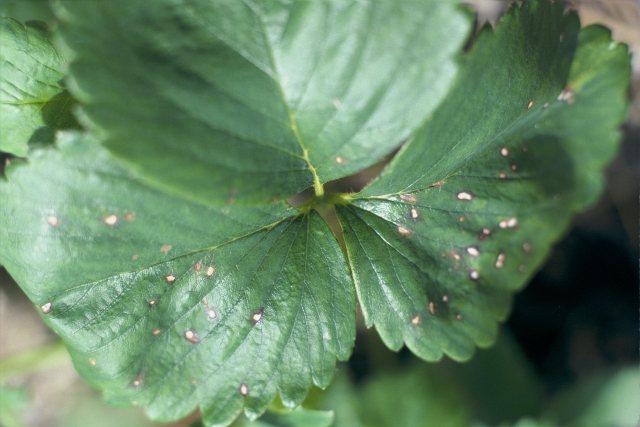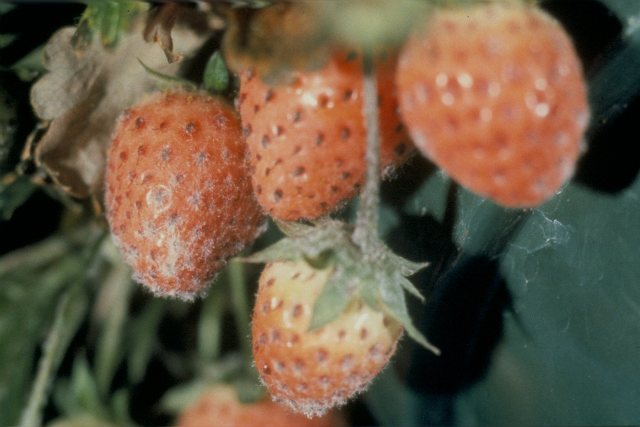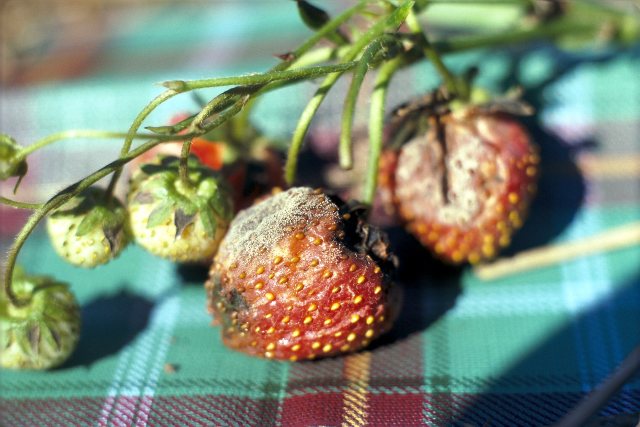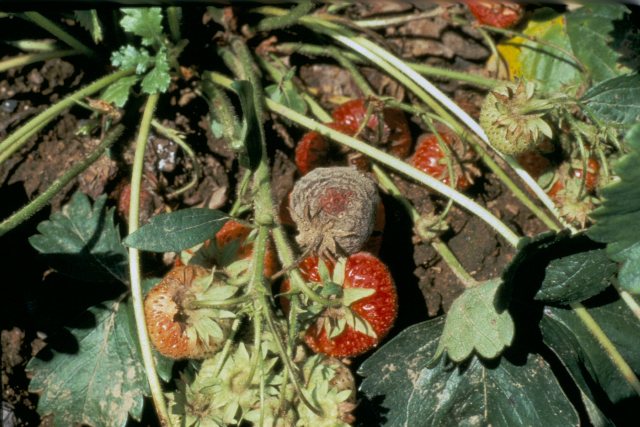Strawberry
Diseases
Diseases Attacking the Leaf
Strawberry fruit fungal diseases are usually not a problem during an average dry prairie summer. Prairie strawberry growers do not regard leaf diseases as a serious concern since they do not appear until after picking. After renovation, a healthy foliage canopy must be maintained for fruit bud set and storage of winter food reserves.
Risk of strawberry leaf and fruit diseases is reduced with renovation and removal of tops from the field. Tops are an inoculum source that may reinfect foliage the following year under suitable conditions.
Leaf spot (Mycosphaerella fragariae [Tul.] Lindau)

This disease first appears on leaves as purplish spots that resemble leaf scorch (see color section). Later these spots enlarge to a diameter of 0.13 to 0.25 in (3 to 6 mm). The centers become grey or white with reddish to purplish borders. Leaf petioles or stalks, stolons, runners and, to some extent, calyxes (caps or hulls) may be attacked.
Plants and leaves are mostly susceptible early in the growing season and in late summer, especially where growth is very succulent. The leaf spot fungus may also attack the fruit and cause black seed.
Spores of the fungus form on the spots and are spread by rain, hands, tools and clothing when plants are wet. Some cultivars are more susceptible to leaf spotting than others. Timely fungicide sprays are an effective method of control.
Powdery Mildew (Sphaerotheca macularis)

Powdery mildew affects all above ground parts of the strawberry plant. Leaves, flower calyxes and fruit all support mildew growth. Infected leaves curl upward, become purplish on the underside and, in severe instances, develop badly burned areas at the margin. A white, powdery fungus growth may be seen on the underside of severely affected leaves. Powdery mildew develops in the spring and fall.
Infection begins in the spring soon after plant growth starts. The spread is gradual and may not be noticed until most plants in the field are infected. If a severe outbreak occurs before picking, the crop may be greatly reduced. Symptoms are most noticeable on warm, dry days.
Dense shelterbelt plantings that restrict good air flow will favour the spread of this disease. Timely fungicide sprays are an effective method of control.
Diseases Attacking the Fruit
By far the most important strawberry diseases are the fruit rots caused by several fungi. They are capable of destroying a large percentage of the fruit. Picking and packing are also more costly when these diseases are present in the field. Losses vary with time and location, as well as weather conditions from first bloom through harvest.
Grey Mold Botrytis cinerea

Grey mold is very common and often causes serious losses in strawberries. Customers usually complain of off-flavored fruit if berries infected with grey mold are eaten. This disease affects blossoms and blossom stalks of green or ripe fruit. Infection usually starts in the blossom and may destroy the entire blossom stalk. The blossom infection can enter a dormant period in the calyx or hull, then become reactivated to cause fruit rot.
The rot is soft and light brown in color. The fungus may spread to other blossoms and berries through direct contact, or by spores that are brown or splashed. A fine grey powdery growth develops and infects blossoms, fruit stalks, fruit and other plant parts (see color section). Fruit rot and grey mold may appear on the picked fruit for one or two days.
Grey mold is favoured by shade or dense foliage in the bed and extended periods of excessive moisture. The likelihood of infection is increased by cool spring and summer temperatures and high humidity from frost control techniques, general irrigation and natural rainfall. Black plastic mulch dries off faster than straw and therefore slows mold growth. Fruit rot can also be favoured by factors that produce soft fruit, such as high application of nitrogen during fruiting.
Apply protective fungicides at bloom and continue until harvest if cool wet conditions prevail.
Botrytis Grey Mold Management Chart
Other Fruit Rots

Several minor rots can attack fruit and cause significant damage to certain day neutral cultivars under ideal environmental conditions.
Leather rot (Phytophthora cactorum) gives fruit a dull or lifeless appearance with color ranging from bleached to purple to nearly normal. Fruit is discolored internally and externally and usually has a dry leather appearance (see color section).
A second fruit rot is caused by anthracnose fungi (Gloeosporium spp.). Unripe to ripe fruit develops compact, sunken areas ? tan to dark brown in colour ? which become circular, water-soaked lesions.
Tan brown rot caused by Hainesia lythri is commonly found in September on fruit of day neutral strawberries. The symptoms are small, tan, slightly sunken spots on the fruit. As the rot progresses into the berry the decayed tissue is replaced with fungal mycelium which becomes dry and spongy. Hainesia attacks a wide range of weed hosts which may occur in the vicinity of strawberry plants and serve as a source of infection. The fungus can overwinter on infected plant debris. Control by cultural practices such as mulching, weed control and removal of plant debris.
Diseases Attacking the Root
Black Root Rot
This disease is caused by a number of different fungi including Pythium, Fusarium and Verticillium, which are common in most soils. Young, healthy roots are white or clear in appearance. With age, the roots become brownish or darker on the surface and have a yellowish living core. When infected by root rots, main roots appear dark and patchy, then turn black. The entire root decays, including the core. Feeder roots are killed quickly.
Root rot fungi are favoured by winter injury, poor drainage and acid or alkaline soils. Plants affected by root rot have reduced vigor and may die. The disease may prevent newly set plants from becoming established, and may kill established plants before or during harvest. The time required to kill the plant depends on factors such as soils, temperature, moisture and growing practices.
Storage Mold
This mold can kill new plants and is caused by several organisms. Do not plant mold infected plants. Dipping plants prior to planting in a recommended fungicide bath is a good preventative measure.
Verticillium wilt Verticillum albo-atrum (Reinke Berth)
Although not common, the disease tends to be prevalent and destructive in semi-arid, irrigated areas. It is carried by the soil borne fungi Verticillum albo-atrum (Reinke Berth), which may spread from tomatoes, potatoes, alfalfa and other annual and perennial crops. This fungus persists in the soil for up to seven years. Symptoms include browning at leaf margins and between veins, followed by eventual collapse. Inner leaves are stunted but tend to remain green and turgid until the plants die. Control is obtained by soil fumigation with methyl bromide. Losses can also be reduced by planting cultivars with moderate to high resistance to this disease.
Viruses
Viruses can be identified by the symptoms of plants in the field or by use of indicator plants. Virus diseases are usually named after the symptoms they produce. For example, "Witches Broom" produces a stunted plant with many small leaves originating from one point, creating a "broom" effect.
Virus diseases are spread by insect, chiefly aphids and leaf hoppers. Once a plant is infected, it does not recover. All plants attached to it by runners also become infected through the transfer of virus particles in the plant sap.
To reduce the spread of virus diseases, use certified plants, followed by a full spray program. As well, remove any off-type plants from the field. Growers located near large native stands of wild strawberries must be more vigilant to avoid virus contamination.
For more information, consult Fruit Crop Protection Guide for Commercial Growers
